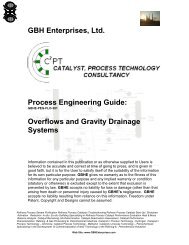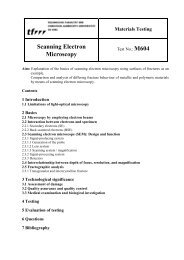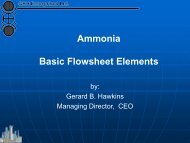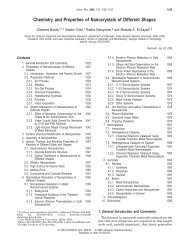Vulcan Series Chloride Removal Technology VGP CRT 2000 and ...
Vulcan Series Chloride Removal Technology VGP CRT 2000 and ...
Vulcan Series Chloride Removal Technology VGP CRT 2000 and ...
You also want an ePaper? Increase the reach of your titles
YUMPU automatically turns print PDFs into web optimized ePapers that Google loves.
5. FAQ: <strong>VGP</strong> <strong>CRT</strong> <strong>2000</strong> & 3000<br />
1. Does your catalyst give off any byproducts as a result of the HCl reaction<br />
mechanism ?<br />
No by-products are formed ( eg PCA's - "green oils" or organic chlorides ), however, the<br />
HCl is removed by chemical reaction, resulting in the production of 1 mole of H 2 O <strong>and</strong> no<br />
C0 2 evolution, as is the case with some competitive chloride guards containing<br />
“carbonates”. This is very important as carbon oxides can have a deleterious impact on<br />
Isomerization catalyst, when the make gas from the catalytic reformer is used as feed gas<br />
to the Isomerization Unit.<br />
2. What is the impact of H 2 O, 1 to 50 ppm, on the catalyst in either the vapor or liquid<br />
phase?<br />
Water concentration: Reasonable quantities of water (0.1 %) are necessary to achieve a<br />
reasonable degree of chloride loading on competitive alumina based adsorbents /<br />
absorbents; however the performance of <strong>VGP</strong> <strong>CRT</strong> <strong>2000</strong> & 3000 requires significantly<br />
less water. Thus H 2 O vapor in the aforementioned range will have no mal-affect on the<br />
performance of <strong>VGP</strong> <strong>CRT</strong> <strong>2000</strong> & 3000.<br />
3. What will be the impact of higher levels of halogens for short periods of time? Will<br />
the catalyst remove all of the chlorides down to the 0.1 ppm level or will the outlet<br />
concentration increase?<br />
The unique structure <strong>and</strong> composition of the <strong>CRT</strong> <strong>Series</strong> catalyst, based on its<br />
engineered shape with relatively high geometric surface area, allows for fast <strong>and</strong><br />
efficient catalytic reaction, with HCl hitting the surface of the catalyst.<br />
Both the low <strong>and</strong> high temperature <strong>CRT</strong> catalyst has been specifically formulated to<br />
give an optimum density <strong>and</strong> high availability of the active ingredients, which means<br />
exceptionally high levels of chloride loading, can be achieved. It is inherent to systems<br />
using reactive adsorption that they will have higher chloride saturation capacities than<br />
systems using chemisorption for HCl removal. Chemisorption based systems can only<br />
count on a monolayer of HCl chemisorbed on to the surface. On the other h<strong>and</strong><br />
chemical reaction (reactive adsorption) systems utilize the whole catalyst volume to 'lock<br />
in' the chloride. The HCl mass transfer zone when using <strong>VGP</strong> <strong>CRT</strong> <strong>2000</strong> & 3000 is small<br />
in relation to that achieved by competitive materials. It is the combination of realistically<br />
achievable saturation loading <strong>and</strong> the mass transfer zone that will determine the average<br />
chloride loading at EOR.<br />
Refinery Process Stream Purification Refinery Process Catalysts Troubleshooting Refinery Process Catalyst Start-Up / Shutdown<br />
Activation Reduction In-situ Ex-situ Sulfiding Specializing in Refinery Process Catalyst Performance Evaluation Heat & Mass<br />
Balance Analysis Catalyst Remaining Life Determination Catalyst Deactivation Assessment Catalyst Performance<br />
Characterization Refining & Gas Processing & Petrochemical Industries Catalysts / Process <strong>Technology</strong> - Hydrogen Catalysts /<br />
Process <strong>Technology</strong> - Ammonia Catalyst / Process <strong>Technology</strong> - Methanol Catalysts / process <strong>Technology</strong> – Petrochemicals<br />
Specializing in the Development & Commercialization of New <strong>Technology</strong> in the Refining & Petrochemical Industries<br />
Web Site: www.GBHEnterprises.com








